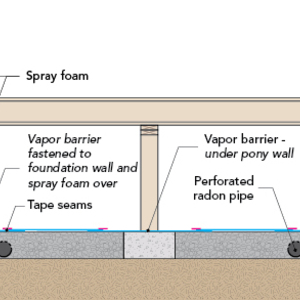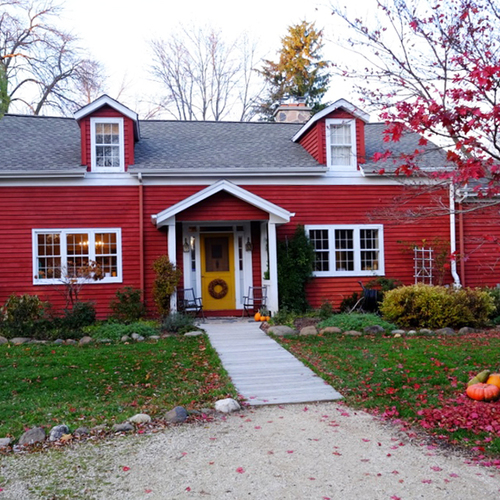
Radon is a naturally occurring soil gas that is present in many locations throughout North America. The gas can’t be seen, smelled, or tasted but it is known to cause lung cancer. Radon control systems have been in the IRC for a few cycles now. In Appendix F, there are several options for how these systems can be constructed when building new. There are also statagies for mitigating elevated levels of radon in existing buildings. (A helpful resource: Soil Gas Mitigation Standards for Existing Homes.)
How does radon enter a home?
Radon comes from radioactive decay in rocks that moves though the soil and into the atmosphere. If there is an enclosed structure between the ground and the atmosphere, radon gas can accumulate inside the structure. Radon usually enters a home through cracks or penetrations in a floor system that is in direct contact with the soil. This floor system can be a basement slab, the concrete floor of a slab-on-grade home, (or a concrete-free slab-on-grade system). Another source can be the dirt floor in a crawlspace. There are also industry mentions of radon from granite used in building materials, like granite countertops, although most experts agree that the amount of radon released from building materials is very small.
Radon mitigation in new construction
Many of the systems being designed for new homes are passive, meaning any soil gas present beneath the foundation is naturally vented by way of a pressure differential to the outside. A vent stack used in new construction must be a pipe with a minimum 3-in. diameter extended from beneath the slab or floor system that is in direct contact with the soil, up through the building and out above the roof line. If an active system is needed, as is the case when radon…
Weekly Newsletter
Get building science and energy efficiency advice, plus special offers, in your inbox.

This article is only available to GBA Prime Members
Sign up for a free trial and get instant access to this article as well as GBA’s complete library of premium articles and construction details.
Start Free TrialAlready a member? Log in















10 Comments
So the implication is the "makeup air" from the active radon system is coming from the basement/crawl causing it to go negative? Therefore impeccable air sealing would prevent that?
My radon/vapor barrier is being sealed to the footing before pouring the slab, but I am still planning to seal all the slab/footing connections with Tremco Acoustical Sealant to have that concrete air barrier. The outside of the house is all covered with self applied membranes from the footing up and over the house and back down. Plus additional spray foam at rim and ceiling joists, and sealant at the sill. So the air "should" flow directly from the sub-slab gravel up through the radon pipe without pulling air from within the house and creating negative pressure, right?
How does a radon vent (and worse yet an active one) affect the airtightness performance of a super tight house?
That's a great question. If all the details are done correctly, there should be no, or very little connection between the sub-slab radon system and the home. During blower door testing, I've found this is not always the case. Leaking around the pipe penetrations and the tub and shower drain boxes commonly used is something I'm seeing. I found one by dumb luck a couple years ago and now I check these areas when they are accessible during a test. My advice is to perform a blower door test during construction, as early in the process as possible and pay attention to all the penetrations through the concrete. They still can be easily sealed at this point.
What can happen if a radon vent (active) is causing a negative pressure issue inside a home? The answer to most building science questions is it depends. In a very cold climate, you may end up with a condition like Gary Nelson, over ventilating which can cause a home to become dry during the winter months. In a hot and humid climate, you may be dragging in humidity. Both may affect energy costs.
Thanks for the question!
Can you give more details about the tub and shower drain boxes? Are you referring to plumbing stack vents?
When you do blower door testing do you do it with the radon system running or off?
drain boxes are holes in the concrete for installation of drains. He's just saying some people are installing these and not properly sealing them, creating air passageways between the basement interior and the sub-slab region. Make the floor an air barrier, is what it comes down to.
Gotcha. Thanks!
Thanks Tyler!
The statement that in existing homes, action is needed only if the radon level is above the 4 pCi/l leaves some important information out. From the EPA's radon info website: "EPA recommends homes be fixed if the radon level is 4 pCi/L (picocurries per liter) or more. Because there is no known safe level of exposure to radon, EPA also recommends that Americans consider fixing their home for radon levels between 2 pCi/L and 4 pCi/L."
Thanks for that clarification, Nick.
Probably an obvious reason not to do this I'm missing, but why are we not prepping for radon by routing the exhaust pipe out to the side of the slab instead of a stub pipe through the slab? Seems a whole lot tidier and with less risk of messing up the details.
RyanHow,
If the pipe is routed out the side of the slab, you end up with a set-up like you see in the first photo, with a vent stack or fan on the exterior of the house. Much like we did with other plumbing vents which traditionally ran on the outside of the walls, it makes more sense to route them internally and out the roof.
Log in or become a member to post a comment.
Sign up Log in